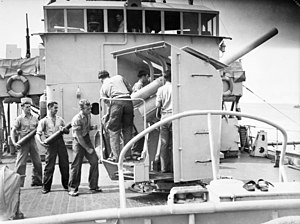QF 4-inch naval gun Mk XIX
| Ordnance QF 4 inch gun Mk XIX | |
|---|---|
 Crew of HMAS Cowra at gun drill, Tarakan Island, June 1945 | |
| Type | Dual-purpose gun |
| Service history | |
| In service | 1939[1] |
| Used by | |
| Wars | World War II |
| Production history | |
| Designed | 1938[1] |
| No. built | 2,023[2] |
| Specifications | |
| Barrel length | 160 inches (4.064 m) bore (40 calibres) |
| Shell | Fixed QF HE, Starshell |
| Shell weight | 35 pounds (16 kg) |
| Calibre | 4-inch (101.6 mm) |
| Breech | horizontal sliding-block |
| Elevation | -10° to +60°[2] |
| Muzzle velocity | 396 metres per second (1,300 ft/s)[2] |
| Maximum firing range | 8,870 metres (9,700 yd) at +40°[2] |
The QF 4-inch Mk XIX gun[note 1] was a British low-velocity 4-inch 40-calibre naval gun used to arm small warships such as Bathurst and Castle-class corvette and some River-class frigate in World War II, mainly against submarines.[3]
Description
It succeeded the higher-velocity World War I-era BL 4-inch Mk IX (typically deployed on Flower-class corvettes in the escort role). The Mk XIX fired fixed ammunition which was 38.5 inches (0.98 m) long and weighed 50 pounds (23 kg).[3] The weight of the projectile was increased from 31 pounds (14 kg) for the Mk IX to 35 pounds (16 kg) for the Mk XIX. The high-angle mounting used for the XIX added some anti-aircraft capability and allowed it to fire starshells to illuminate the battle area at night.[2]
Ammunition
- Canadian gunners with fixed rounds
Surviving examples
- On HMAS Castlemaine at Williamstown, Victoria, Australia.
- On the parade ground at the Irish Naval Service Base, Haulbowline, Co. Cork, Ireland
Notes
- ^ Mk XIX = Mark 19. Britain used Roman numerals to denote Marks (models) of ordnance until after World War II. This was the nineteenth model of British QF 4-inch gun
References
Bibliography
- John Campbell, "Naval Weapons Of World War Two", Annapolis : Naval Institute Press, 1985, ISBN 0-87021-459-4
External links
- Tony DiGiulian, Britain 4"/40 (10.2 cm) QF Mark XIX


